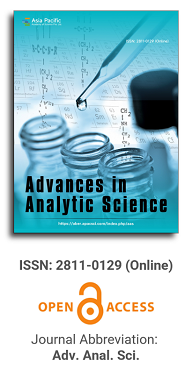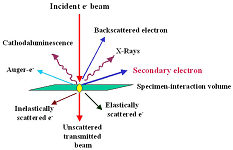
Asia Pacific Academy of Science Pte. Ltd. (APACSCI) specializes in international journal publishing. APACSCI adopts the open access publishing model and provides an important communication bridge for academic groups whose interest fields include engineering, technology, medicine, computer, mathematics, agriculture and forestry, and environment.

Scientific and technological progress is reshaping our world at an unprecedented rate, bringing opportunities and challenges to all walks of life. Scientific and technological innovation shows broad application prospects in fields such as environmental monitoring, biomedicine, energy development, materials science, and agriculture. Faced with challenges such as data quality, model complexity, environmental safety, and technical costs, future research should strengthen data integration and intelligent analysis, high-resolution detection technology, digitization and automation, and the application of green technology. At the same time, interdisciplinary cooperation is essential to promote scientific and technological innovation. Through continuous exploration and innovation, it is possible to meet global challenges and create a better future.
Issue release: 31 December 2024
Over the past two decades, microwave kinetic inductance detectors (MKIDs) have gained exceptional importance in millimeter and sub-millimeter astronomy. MKIDs consist of thin strip resonators capable of detecting changes in the surface impedance of superconductor strips, which result from variations in resonance circuit properties. The principal noise in MKIDs comprises excess frequency noise and two-level system noise. In this paper, we propose a technique to mitigate the effect of two-level system (TLS) noise in MKIDs using a parallel plate capacitor with three layers of high ε dielectrics. To achieve this, we employ three layers of Al2O3, HfO2, and TiO2 with equal thickness between the capacitor plates. The experimental results demonstrate a nearly 30% reduction in TLS power spectral density.
Issue release: 31 December 2024
The article presents the results of testing the developed method for determining mobile sulfur in wood ash and various soil substrates. Determination of sulfur in sulfate form in presence of orthanilic K is possible due to the indicator’s ability to form coloured complexes with Ba2+ ion. We examined the ranges of volumetric and photometric determination. The accuracy of the analysis was determined by comparison with a certified method. We present optimal conditions for the successful determination of the mobile sulfur with the titration and with spectrophotometric method. The results of experiments confirming the capabilities of the method under study are presented.
Issue release: 31 December 2024
Many metropolitan areas face significant environmental challenges posed by improper disposal and management of solid waste. As a result, environmental risks have emerged as a pressing concern, prompting dedicated research efforts. This study on environmental risk prediction of Dar es Salaam SW coincides with a mounting governmental effort over rising pollution levels from inadequate SW management. Using the multi-layer perceptron artificial neural network (MLP-ANN) model, it effectively examines the prevailing conditions and forecasts waste generation rates (WGRs) and environmental risk index (ERI) associated with SW pollution. As confirmed with 94.5% prediction accuracy and 86.5% success rate of the MLP-ANN model, WGRs in Dar es Salaam have doubled in less than two decades. Besides, over 40% of the overall generated SW is left unattended. Consequently, the ERI exhibits a consistent upward trajectory throughout the assessment period, with intermittent fluctuations between Level II and III but a persistent overall increase. Projections indicate an escalation of ERI to Level IV by 2025/26 and to a critical threshold (Level V) by 2038. The key indices such as pressure, state, and impact are anticipated to reach critical thresholds ahead of the comprehensive ERI. This underscores the imperative for timely interventions and the urgency of addressing SW management issues to curb the escalating environmental risks in Dar es Salaam and other metropolises with similar challenges.
Issue release: 31 December 2024
The paper deals with innovative equations tackling exactly stochastic dynamics mass spectrometric experimental variable intensity of peak per span of scan time. They overcome limitations of classical methods for semi-quantifying analytes developed, so far, and exactly grasp observable variables and their fluctuations; thus, succeeding in determining analytes reliably both quantitatively and 3D structurally via soft ionization mass spectrometry. Given the paper’s goal of illustrating their crucial effect on mass spectrometric methodology as an irreplaceable approach to structurally analyse species, this study offers stochastic dynamics-based analysis of nucleotides. The major contribution is providing empirical justification of aspects of structural mass spectrometry analysing uridines and pseudouridines. The virtual identity of fragmentation patterns causes significant analytical challenges. The same is true for methyl-substituted guanosines which are often determined as mixtures. There are used ultra-high resolution electrospray ionization mass spectrometry, high accuracy computational static and molecular dynamics methods, and chemometrics. The study discusses controversial aspects of classical techniques. It illustrates how the innovative equations resolve disputable problems of structural analysis of nucleotides. It supports advanced formulas for achieving superior performances. There are obtained coefficients of linear correlation |r| = 0.9994–0.99923 determining N1-methyl-pseudouridine modified diphosphate compared with 5-methyluridine diphosphate N-acetylglucosamine. There are determined N2,N2-dimethylguanosine, uridine, pseudouridine, 5-methyl-uridine, 1-methyl-pseudouridine, 5,6-dihydrothymidine, galactosyl-queuosine, mannosyl-queuosine, adenosine, 2’-O-methyl-5-hydroxymethylcytidine, uridine triphosphate, thymidine diphosphate N-acetylglucosamine, 5-methyluridine diphosphate N-acetylglucosamine, and 7-methylguanosine-5’-phosphate modified derivative, respectively.
Issue release: 31 December 2024
The prompt and precise identification of microorganisms is crucial for successful clinical diagnostics and the prevention of infectious disease outbreaks. Traditional diagnostic methods often suffer from limitations such as extended processing durations, elevated expenses, and the necessity for specialized laboratory equipment. In this research, we propose the development of novel nanostructured biosensors that utilize the distinct characteristics of nanomaterials to improve the accuracy, specificity, and efficiency of identifying pathogens. These biosensors are created with the intention of offering point-of-care testing functionality, thus rendering them appropriate for utilization in a range of clinical settings. The integration of advanced nanotechnology with bioanalytical methods aims to create a reliable system for the real-time identification of bacterial, viral, and fungal pathogens. This review encompasses the design, fabrication, and testing of the biosensors, along with a comprehensive analysis of their performance in comparison to conventional diagnostic techniques. The results demonstrate the potential of nanostructured biosensors to revolutionize pathogen detection, offering significant improvements in efficiency and accuracy, which are essential for timely medical intervention and public health management.
Issue release: 31 December 2024
Chemical sensors bridge the gap between the chemical and electrical/optical domains, offering a powerful tool for analyzing our environment. These ingenious devices, with detection limits reaching parts-per-billion (ppb) for some analytes, rely on interactions between a specific material and the target molecule. This interaction, which can involve changes in electrical current, light emission, or mass, is translated into a measurable signal. This review delves into the core working principles of various sensor types, highlighting their diverse applications. From environmental monitoring (tracking air and water pollutants at concentrations as low as 10 ppb) to medical diagnostics (detecting biomarkers for early disease identification), chemical sensors play a crucial role in shaping a safer and healthier future. Recent advancements, such as miniaturization and integration with nanomaterials, promise even greater sensitivity, portability, and affordability, paving the way for a new era of sensor-driven innovation. This review article explores these advancements and their potential impact on various fields, inspiring further development and exploration of this transformative technology.
Issue release: 31 December 2024
Oil and natural gas, as fluid minerals, flow within the Earth’s crust under the influence of various driving forces such as pressure, buoyancy, and gravity. This phenomenon is known as hydrocarbon migration. Hydrocarbon migration is a crucial component of the reservoir formation process, and accurately analyzing its direction affects the precision of trap prediction, well positioning, reservoir size, and morphology evaluation, thereby influencing the difficulty and cost of hydrocarbon development. However, most of the currently discovered hydrocarbon reservoirs have undergone multiple transformations or destructions, increasing the challenges of hydrocarbon development. Through an extensive literature review, this paper summarizes and categorizes the main current methods of studying hydrocarbon migration, including sedimentological methods, geochemical tracers, numerical simulation, and geophysical methods. Furthermore, this paper discusses and explores the frontier trends in hydrocarbon migration, mainly reflected in artificial intelligence (AI) methods, digital oil fields, geological big data analysis, and high-resolution seismic imaging technology. Looking to the future, there are significant opportunities in hydrocarbon migration research in data integration and intelligent analysis, high-resolution detection technology, digitization and automation, and the application of green technologies. However, there are also severe challenges regarding data quality and integration, the complexity and uncertainty of models, environmental and safety concerns, technology costs, and interdisciplinary collaboration. In conclusion, this paper clarifies the hydrocarbon migration process by reviewing, summarizing, and analyzing existing literature to understand hydrocarbon reservoirs’ formation and distribution patterns. It also delves into the mainstream methods, frontier trends, and prospects of hydrocarbon migration technology, providing valuable insights for future research.
Issue release: 31 December 2024
The inorganic compound water is the second most essential component after air for perpetuation of life on the planet. Due to human activity the natural resources of water are highly contaminated. The water reservoir contains physical, chemical and biological impurities. Sometimes radioactive materials are discharged in the reservoir creating even hazardous effects. The presence of heavy metal ions in drinkable water is a major global challenge for mankind. The heavy inorganic materials can be separated using various techniques. With the advancement in modern science, nanomaterials are found to be effective in removal of heavy inorganic materials from water. As surface area at nanoscale increases, the possibility of adsorption also gets increased. Therefore, nanomaterials are being effectively used in water purification techniques. In this review, we will focus on how heavy metals with negative environmental consequences may be removed using an adsorption approach that involves iron oxide nanoparticles, which has been shown to be effective in this field. We are going to discuss several methods along with current advancements in iron oxide nanoparticles for heavy metal ion adsorption from water. The discussion covers candidate synthesis of iron oxide nanoparticles, mechanisms that enable the applications, advantages, and limitations as compared to existing processes and their adsorption mechanism. Apart from this we have focused the application of adsorption particularly in veterinary science and animal husbandry. The phenomenon of adsorption is of paramount importance in veterinary pharmacology as well.
1.jpg)
Prof. Sivanesan Subramanian
Anna University, India


 Open Access
Open Access



.jpg)
